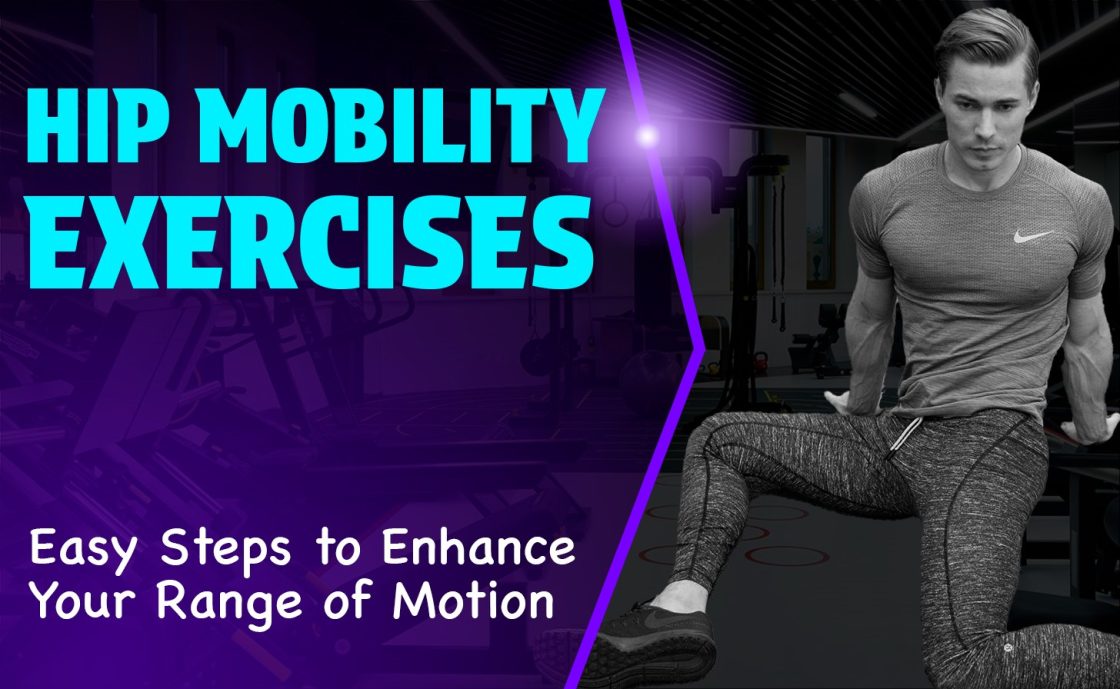Imagine you’re on your usual morning run. The breezy wind graces your face, your heart pumps with energy, and you’re about to hit your best time. Just as you’re at the peak of your delight, a sudden pang restricts your hip. Familiar? For many of us, hip discomfort halts activities we love and can reflect a lack of mobility. However, things don’t have to be that way. You’ll learn some creative hip mobility exercises from this writing that will increase your range of motion, reduce pain, and motivate you to move more.
Exploring Hip Mobility: Why is it Important?
It’s the unsung hero of our bodies. It allows us to prance, leap, sprint, or even take those much-needed evening strolls. Yes, we’re talking about hip flexibility. But have you ever put substantial thought into what it is or why its importance is often emphasized by fitness experts and enthusiasts alike? Let’s explore together, dissecting each facet of this much-spoken-about yet understated aspect of our bodily function.
The Functions that Hold Us Together
The mobility of our hips isn’t just a trivial aspect we can breezily ignore. It plays an indelible part in our daily lives. Picture this – every time you stand up from your cozy couch to fetch another bag of chips, every step you take during that routine morning jog, every dance move you pull off at a party, much of it hinges on the health and flexibility of your hips. Even seemingly simple actions such as walking or bending require hip flexibility.
More Than Just Movement
It’s not just about locomotion. Good mobility is woven into the core of our overall bodily health. Preserving good alignment and posture, it is essential in lowering the chance of injury. The more mobile we are, the less strain we place on our other body parts, which lowers the risk of lower back, knee, and ankle ailments and discomfort.
Proper Functioning: The Key to Healthier Living
Who doesn’t want to be agile, able to move without discomfort, and enjoy a lifestyle brimming with physical activities? Proper functioning of our hip’s natural flexibility is pivotal in achieving this healthier and more active lifestyle. It’s the linchpin that holds our ability to move freely and comfortably together.
Mobility: For A Future Free of Restrictions
As we age, many of us face the daunting prospect of reduced mobility. However, by incorporating exercises that promote mobility into our routines, we ensure a form of ‘preventive maintenance,’ facilitating flexibility and strength for the future.
The essence of mobility, hence, spirals beyond just aiding movement. It forms a crucial link to our overall health, affects our ability to perform tasks, influences everyday comfort, reduces the risk of injuries, and, above all, lays the foundation for a future free of mobility restrictions. Understanding this can lead to a profound appreciation of how your body works and spur an informed approach to nurturing your overall wellness. After all, you’re worth it!
Getting Familiar with Hip Anatomy: The Cornerstone of Movement
When we talk about moving, grooving, and improving our overall physical health, understanding a tiny bit about our hip anatomy isn’t just for doctors or fitness pros. It’s for anyone who moves! A closer look at our hip’s structure helps us get why certain movements feel the way they do, and why sometimes discomfort sneaks into our routine. So, let’s simplify and dive straight into what makes our hips the superheroes of daily movement and flexibility.
The Hip Bones: Your Body’s Natural Ball and Socket
The hip, in its glory, is a marvel of nature’s design – a perfect example of a ball and socket joint. Imagine your hip as a sophisticated, movable joint fashioned by the coming together of two main parts: the ‘ball’ (the femoral head at the top end of your thigh bone) and the ‘socket’ (a curved part of your pelvis called the acetabulum). This design lets your leg sweep forwards and backward, swivel with grace, and, yes, even lets you do those impromptu dance moves.
Surrounding the Hip: Muscles and Ligaments Galore
But what keeps this ball neatly in its socket, and allows your leg the vast range of motion? The heroes behind the scenes: an array of muscles, ligaments, and tendons.
- The Muscles: Think of them as the movers. The major players include the gluteals (your buttocks), the hamstrings (back of your thigh), and the muscles of the inner thigh. Each has its unique role, from propelling you forward to steadying your hips.
- The Ligaments and Tendons: Picture these as the stabilizers. They keep everything in place, allowing the joint to move smoothly without, well, dislocating. The ligaments of the hip like the iliofemoral ligament. prevent over-extension, ensuring our movements remain within a safe range.
Cartilage and Cushioning: The Shock Absorbers
Beneath it all, there’s a thin layer of cartilage covering the ball and inside of the socket. Think of it as nature’s shock absorber, ensuring fluid, low-friction movements between the bones. When this cartilage wears down, moving isn’t as easy or pain-free as it used to be, hinting at why taking care of our hip health is non-negotiable.
The Importance of Synovial Fluid
Lastly, let’s not forget about the synovial fluid, the unsung hero ensuring smooth sailing for your hip movements. This fluid fills the space within the joint capsule, minimizing friction and acting like a cushion every time you jump, run, or even when you’re just taking a casual walk.
Why This Matters
Knowing a bit about the components that make up your hip can be incredibly empowering. It can guide you in choosing the right exercises, understanding the basis of discomfort, and taking proactive steps to maintain or improve your hip’s health. Simply put, a bit of anatomical knowledge gives you the power to look after your hips so they can continue carrying you smoothly through life’s many adventures.
Unlocking the Mystery: The Science Behind Hip Flexibility Workouts
Ever wonder why those twists and bends in your workout routine are more than just movements? There’s a whole science festival happening in your body when you engage in exercises designed to boost the flexibility of your hips. It’s all about boosting your range of motion and keeping those pesky aches at bay. So let’s pull back the curtain and reveal just why those specific bends and stretches are like a magic balm for your hardworking hips.
The Inner Workings of Increasing Range of Motion
A good place to start is understanding the ‘range of motion.’ That’s basically how far you can move a joint in any direction before it sends a ‘that’s enough’ signal. And like a well-oiled hinge, your hips need to move freely and without creaks.
- Creating Space in the Joints: When you perform exercises that focus on the hips, you are literally creating more space in the hip joint. This eases the ball of the joint to swivel more freely in its socket.
- Strengthening Surrounding Muscles: Hip flexibility exercises are not just about the joint; they also strengthen the muscles in the region. By giving those muscles a good workout, you’re allowing them to support the hip joints better, which, guess what, enhances how well you can move.
The Flexibility Factor
Flexibility is like the secret sauce that makes movements smooth and graceful. It’s that quality that grants you the ability to tie your shoes without grunt soundtracks or pick something off the floor without it turning into an unintended yoga session.
- Lengthening Muscles and Tendons: Specific exercises gently pull at the muscles and tendons, encouraging them to stretch a tad further each time. This continuous gentle tug-of-war leads to increased flexibility.
- Maintaining Elasticity of Soft Tissues: Just like a rubber band, you want the soft tissues around your hips to maintain elasticity. This way, they can handle stretch and movement without snapping.
The Benefits Beyond the Obvious
Now, let’s talk about the goodie bag of benefits these exercises deliver. Apart from enhancing your daily movements, consistent activity keeps the hip area healthy.
- Preventing Tightness and Strain: By working the hip area, you’re keeping it from tightening up – which, if left unchecked, can lead to strain and overcompensation in other body parts like your back or knees.
- Encouraging Synovial Fluid Production: Think of synovial fluid as your body’s own brand of WD-40. When you get those hips moving, you’re also encouraging the production of this fluid, which means less grinding and more gliding.
Exploring Movement: A Close-Up on Hip Flexibility Routines
Unleash the power of movement in your life with a deep dive into hip flexibility routines. Whether you’re a beginner or a seasoned fitness pro looking to step up your game plan, this detailed guide is designed to get you moving smoothly, effortlessly, and, most importantly, correctly. Now let’s explore the magic carpet that’ll sweep you into a world of increased flexibility and comfort.
Exercise 1: The Dynamic Pigeon Pose
You may already know the traditional Pigeon Pose from yoga, a stretch that’s fantastic for the hips. Let’s tweak it a bit to derive some more dynamic benefits.
Step 1: Beginning in the tabletop position on all fours, place your knees beneath your hips and your hands squarely beneath your shoulders.
Step 2: Lift your right knee off the floor and bring it towards your right wrist. Extend your left leg behind you.
Step 3: Now, here’s where we add the ‘dynamic’ aspect: Gently rock your body back and forth by pushing your hands, enhancing the stretch around your hips. This movement should be slow and steady.
Tip: Make sure to repeat the same process with your left knee.
Benefits: The Dynamic Pigeon Pose is a great exercise to not just stretch the muscles around the hips but also enhance flexibility and range of motion.
Exercise 2: The Hip Flexor Stretch
Are you sitting most of the day? This stretch is about to become your best friend.
Step 1: Begin in a kneeling position, then step your right foot forward so you’re in a kneeling lunge.
Step 2: Gradually shift your weight forward, deepening the stretch in the front of your left hip.
Step 3: Maintain this pose for about 20 seconds, then repeat on the other side.
Tip: You can intensify the workout by reaching up towards the ceiling with your left hand.
Benefits: This stretch is fantastic for lengthening tightened hip flexors, which is common among those who spend much of their day sitting.
Exercise 3: The Butterfly Stretch
In the realm of hip exercises, the Butterfly Stretch reigns supremely due to its effectiveness.
Step 1: With your back to the floor, take a seat. Lean your knees out to the sides and bring your feet together.
Step 2: Hold onto your ankles. Gently lean forward, aiming to bring your torso towards your feet. You should feel a stretch in your inner thighs and hips.
Step 3: Hold this pose for about 30 seconds, then slowly release.
Tip: Ensure not to force your knees down, instead, let gravity do the work naturally.
Benefits: This is a great way to loosen up your hips and lengthen the muscles in your inner thighs.

Steering Towards Flexibility: The Journey of Hip Cars
Like an expert driver steering through busy streets, Hip Rotational Movements guide your hips through their full range of motion, tuning up your joints and muscles for peak performance. Wondering how to bring this superhero exercise into your routine? Buckle up, and let’s dive into the hows and whys of this game-changing movement.
What Are Hip Cars?
Imagine your hip moving not just forward and back but gliding in a circular motion, exploring the outer limits of where it can go. That’s what Hip circles are about: controlled circular movements that take your hip joints on a full tour of their capabilities. This isn’t your average stretch. It’s a deliberate exploration of movement designed to increase flexibility, strengthen the surrounding muscles, and enhance joint health.
Why Your Hips Will Thank You
Your hips aren’t just involved in walking or running; they play a crucial role in balance, strength, and overall mobility. By regularly incorporating this routine:
- You Break Free from Stiffness: Reaching for that high shelf or leaning down to tie your shoe are just two examples of how breaking the chains of stiffness may set you free.
- Your Joints Get a Health Boost: Just like oiling a squeaky door hinge, these rotations help maintain joint health, ensuring smooth movement.
- Strength and Stability Are Enhanced: Strengthening the muscles around your hips leads to improved stability, lessening the risk of falls and injuries.
How to Perform: A Step-by-Step Guide
Ready to take your hips on this rotational journey? Here’s how to do it right:
Starting Position: Find Your Base
- Stand next to a wall or a sturdy chair for support.
- Plant your feet shoulder-width apart, slightly bend your knees, and engage your core.
The Movement: Draw the Biggest Circle
Phase One – Forward Arc:
- Raise one knee as high as it will go without straining, slowly, toward your chest.
Phase Two – Outward Arc:
- While keeping your knee raised, move your knee outward, opening your hip to the side.
Phase Three – The Backward Sweep:
- Begin to extend your leg back, keeping the knee bent, rotating your thigh inward as you move into the backward phase of the circle.
Phase Four – The Return:
- Finally, bring your leg back to the starting position, completing the circle.
Repetition and Frequency:
- Perform 5-10 rotations on one leg, then switch to the other.
- For best results, incorporate Hip Rotational Movements into your daily routine, ideally as part of your warm-up or cool-down exercises.
Tips for Success
- Go Slow: The magic of Hip Rotational Movements lies in the controlled, deliberate movement. Rushing through can decrease its effectiveness.
- Breathe: Keep your breath steady and consistent. Oxygen is a key ingredient in the flexibility feast.
Hip Circles are your trusty vehicle for improved movement, softer steps, and an overall enhanced quality of life. By investing just a few minutes a day into this practice, you’re not just moving; you’re moving forward.
Unlocking Fluid Motion: The Essentials of Hip Mobility Stretches
Your hips are the central hinges of your body’s daily dance, from chasing after buses to swaying with your favorite tunes. Ensuring these pivotal joints remain flexible can turn every groovy move into a smooth glide. Dive into the world of hip stretches, not just as a must-do on your workout list but as a daily nod to your body’s need for fluidity and grace. Let’s explore the stretches that will keep your hip joints performing an elegant ballet throughout your daily hustle.
The Foundation of Stretching
Before we leap into the nuts and bolts of specific stretches, let’s understand why they’re the silent heroes in our journey to greater flexibility. Considering your hips are involved in most movements, keeping them limber is like keeping the wheels of your car finely tuned – it just makes the ride smoother. Hip mobility stretches work to:
- Ease the Daily Tension: Your hips bear the brunt of daily activities, accumulating tension that can feel like you’re carrying a small elephant around.
- Promote Fluid Movement: Stretching out the kinks helps your hips swivel and sway with less creaking and more pizzazz.
- Support a Sturdy Frame: Flexible hips contribute to a well-balanced body, reducing the load on your back and knees and making you less wobbly.
The Classic Quad Stretch
We’ve all seen the iconic image of someone pulling their foot to their bum to stretch out their thigh. That’s where we start.
- Stand on one leg, using a wall for balance if needed.
- Bend your other knee, bringing your heel towards your glutes.
- To make the stretch deeper, gently grab your ankle and bring it closer.
- Hold the position for up to 30 seconds, then switch and give the other leg the spotlight.
The Warrior of Flexibility: The Lunge Stretch
Embrace your inner warrior to greet strength and suppleness in your hip region.
- Step one foot forward and do a lunge.
- Lower your back knee to the ground.
- Sink into the stretch, feeling it in the front of your hip and thigh.
- Hold for 20-30 seconds, then switch it up: front foot back, back foot front.
The Figure Four: A Hip’s Best Friend
This stretch delves deep into the nooks and crannies of your hip joints.
- Assume a seated posture or recline, ensuring your feet are flat on the ground with your knees in a bent position.
- Cross one ankle over the other knee to form a figure-four.
- Gently encourage the crossed knee away from you.
- If you’re feeling zesty, pull the bottom leg towards you.
- Revel in the stretch for about 30 seconds, then switch to the other side.
Harmony in Movement: Weaving Hip Flexibility into Daily Rhythms
When it comes to keeping your hips happy, consistency is key. It’s not just about dedicating time at the gym or setting aside special moments at home for exercise. The real magic happens when these exercises feel less like tasks and more like natural parts of your day-to-day life. Imagine if every step and stretch contributed to the comfort and flexibility of your hips, it can happen! Let’s explore the simple ways to make hip mobility exercises a seamless thread in the fabric of your days, leading to lasting ease and a whisper of relief with each move you make.
Rise and Shine with Stretch
Before the sun peeks over the horizon or the coffee begins to brew, there’s a golden opportunity to say a gentle hello to your hips.
- Bed-Bound Stretches: As you wake up, take a moment to do a few leg raises or knee-to-chest pulls right in your cozy bed.
- Shower Power Moves: Using the wall for support, perform a few standing figure-four stretches as the warm water washes over you, loosening up muscle stiffness.
Daily Chores
With every chore, there’s a chance to enhance the suppleness of your hips.
- Squat While You Fold: When doing laundry, come into a squat position periodically as you fold each garment, bringing a stretch into your inner hips and thighs.
- Kitchen Counter Calisthenics: While you wait for the kettle to whistle or the microwave to beep, use the kitchen countertop for support as you execute some standing leg swings.
Desk Dynamics
Even when tethered to a desk, there’s room to keep your hips from stiffening.
- Seated Swivels: While sitting, perform some seated hip circles, rotating your pelvis clockwise then counterclockwise.
- Standing Meetings: If possible, stand and do subtle hip exercises like side leg raises during phone calls or virtual meetings.
Child’s Play Interplay
If you have kids or pets, engaging with them can also open up opportunities for hip health.
- Playtime Pliés: Get down on their level for playtime, using this as a chance to stay in a squat position, or lunge while reaching for toys.
Nightfall Nurturing
In the hush of the evening, as you unwind from the hustle and bustle, you can tenderly care for your hips.
- TV Time Twists: While watching your favorite evening shows, sit on the floor and work through some gentle seated twists or butterfly stretches.
- Bedtime Lullaby for Your Hips: Before slipping under the covers, spend a few soothing moments with a yoga strap or towel around your foot to gently stretch the legs and hips in a lying-down position.
Hips in Harmony
By integrating these moves into routines you’re already doing, the exercises will feel more like breathing life into your day rather than another to-do item. Transformation doesn’t have to come through monumental changes; sometimes, it’s the quiet, consistent practices we weave into the mundane that bring the most meaningful relief. Your hips, those unsung heroes that carry you through the day, deserve such nurturing touches.
So let these gentle movements be a symphony that plays softly in the background of your life, every note nudging you towards smoother strides and lighter steps. The result? A happier, more supple you.



